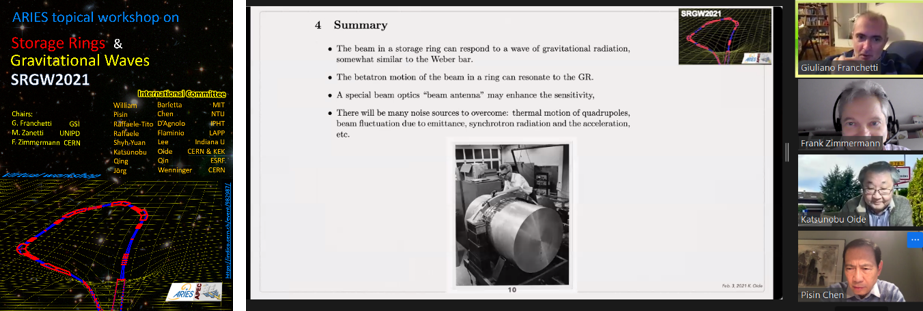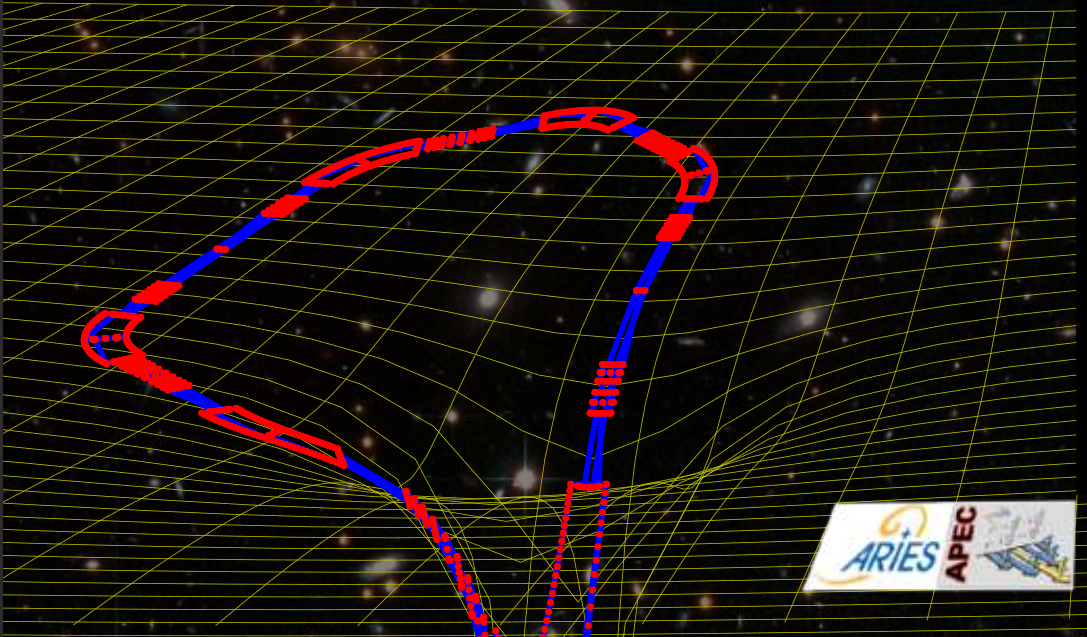After the discovery of gravitational waves (GWs) by the LIGO detector in 2015, and with the advent of proposals for new large storage rings such as the 100 km Future Circular Collider (FCC) or Circular Electron Positron Collider (CEPC), the question whether accelerators can be used for the detection or generation of GWs has gained new importance and urgency.
In February and March 2021, a topical virtual workshop “Storage Rings and Gravitational Waves” (SRGW2021) [1], organized in the frame of the H2020 project ARIES, shed new light on this tantalizing possibility. More than 100 accelerator experts, particle physicists and members of the gravitational physics community jointly explored possible novel directions of accelerator research.

After Jorge Cervantes (ININ Mexico) presented a vivid account of the history of gravitational waves, Bangalore S. Sathyaprakash (Penn State, USA and Cardiff U., UK) reviewed the main sources of gravitational waves expected. The GW frequency range of interest extends from 0.1 nHz to 1 MHz. Raffaele Flaminio (LAPP Annecy) described the extreme precision of the VIRGO and LIGO light-interferometers, while Jörg Wenninger (CERN) reported the impressive sensitivity of large lepton or hadron storage rings – LEP and LHC – to small effects, such as the tides or earthquakes elsewhere.
A gravitational wave can resonantly interact with either the transverse betatron motion of a stored particle beam at a frequency of several kHz, or with the longitudinal synchrotron motion at a frequency of 10s of Hz. Katsunobu Oide (KEK and CERN) discussed the betatron resonances excited by GWs, and proposed special beam-optical insertions, serving as “gravitational-wave antennas”, to enhance the resonance strength. Suvrat Rao (Hamburg University) discussed the longitudinal beam response [2]. This response is enhanced for perturbations close to the synchrotron frequency. Raffaele D’Agnolo (IPhT) estimated the sensitivity to the gravitational strain h, without any backgrounds, as
Figure 2 superimposes ideal sensitivity curves from revolution time at the LHC and from the transverse resonant response for a storage ring with GW antenna optics, along with expected sources, in the strain-frequency plane.
![Ideal noise-free GW sensitivity at the LHC for 1 ps resolution in revolution time (red curve, Suvrat Rao, from [2]) and ideal transverse resonant betatron response sensitivity of a 37 km ring with GW-antenna optics under two different assumptions for the beam-position measurement resolution (green and blue curves, Katsunobu Oide and Frank Zimmermann), in the strain-frequency plane, superimposed on a picture of expected sources taken from http://gwplotter.com/. Also shown is the predicted strength of the LHC as a gravitational source for the coherent emission of gravitational synchrotron radiation, assuming all protons in a beam are contributing coherently (red star, Pisin Chen). All three storage-ring lines and the marker require confirmation.](/sites/default/files/inline-images/sensitivity_new.png)
Workshop participants discussed possible coasting beam experiments, and the sensitivity of heavy ions or of cold crystalline beams. Witek Krasny (LPNHE) suggested relying on “atomic clocks” as for the Gamma factory. Andrey Ivanov (TU Vienna) discussed the possible shrinking of storage ring circumferences under the influence of the relic GW microwave background [3].
High-quality superconducting radiofrequency cavities could offer an alternative venue to detect gravitational waves, as presented by Sebastian Ellis (IPhT). Atomic beam interferometry is another promising approach, pursued by Oliver Buchmüller (Imperial College London) and John Ellis (King’s College London).
Pisin Chen (NTU Taiwan) discussed how relativistic charged particles in a storage ring can emit gravitational waves [4]. If all particles and bunches excited the GW coherently the spacetime metric perturbation could be as large as
The concluding workshop discussion was moderated by John Ellis (King's College London).
Gravitational waves are a unique tool to understand the today’s universe and to unravel its history. The great excitement and interest prompted by the ARIES SRGW2021 workshop, and the preliminary findings, call for further investigations.
References
[1] SRGW2021 workshop web site https://indico.cern.ch/event/982987
[2] S. Rao et al. 2020 Phys. Rev. D 102, 122006
[3] A. Ivanov et al. 2002 arxiv gr-qc/021009
[4] P. Chen 1994 SLAC-PUB-6666 and 1995 Phys. Rev. Lett. 74, 634
[5] G. Diambrini Palazzi et al., 1987 Phys. Lett. B 197, 302

